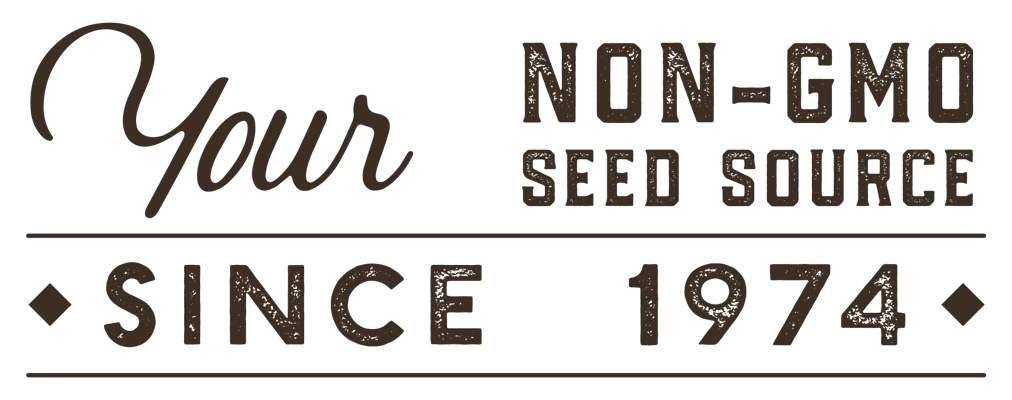Download Free Vegetable Growing Guide PDF
Growing Brandywine Yellow Slicer Tomatoes in the Vegetable Garden
To give yourself the best shot at a good harvest, start your tomato plants ahead of time indoors. About two months before the last spring frost, use well-draining potting soil and plant 2 or 3 seeds a quarter inch deep in each cell. Use a gentle watering can or mister hose attachment to water the seeds. The seedlings should be kept warm and moist, and they will emerge in 7-10 days. When they break the soil surface, promptly move them to direct sunlight or provide a grow light. They should receive at least 8 hours of light each day and 8 hours of darkness each night. Once the seedlings are 1-2 inches tall, thin them so that there is only one strong seedling per cell. Once the seedlings are 1-2 inches tall, thin them so that there is only one strong seedling per cell.
When they have developed two true leaves, fertilize with a mild fertilizer, compost tea, worm castings, or a dedicated commercial tomato fertilizer. When the seedlings have grown to fill the cell with their roots, transplant them into 6-inch pots to continue developing. Around two weeks before their predicted transplant date, begin gradually acclimatizing them to the outdoors. Do this by leaving them outside for a few hours during the warmest part of each day and adding a few more hours as you get closer to the transplant date. Keep them indoors anytime temperatures get to 50 F or below. Once temperatures are generally around 70 F, transplant the seedlings into the garden.
Provide tomato plants with loamy, well-drained, lightly acidic soil. Adding compost to the soil increases water retention, acidity, and nutrient density. The tomato plants must receive full sun and warm temperatures. When transplanting, remove all the leaves but the top 2-3 sets and bury the plant so that only the reserved leaves are above the soil. This will encourage lots of roots to develop. Given the right environment, tomato plants, unlike other plants, can sprout roots from anywhere along their stem. Apply an even fertilizer at the time of transplantation.
Throughout the season, prune the plant by removing suckers and bottom leaves. Tomato plants must receive full sun throughout the season to fruit and thrive. Fertilize again about halfway through the season. Water them in the morning if possible, and avoid splashing the leaves. Brandywine reaches maturity around 85 days after transplantation.
Harvesting Brandywine Yellow Tomatoes
This indeterminate variety will produce fruit until the plant dies. As soon as the tomatoes are ripe, they should be picked. Being quick about it avoids overburdening the plant and encourages more fruit. Harvest the fruit when it is yellow, shiny, and firm. A soft or squishy fruit indicates overripeness. Gently twist or snip the tomato to remove it from the green part. If you know that an impending frost might kill your plant, but it still has fruit, harvest the rest, regardless of ripeness, and continue ripening them indoors.
About Brandywine Yellow Tomato Garden Seeds
Brandywine Yellow is a potato leaf variety. The leaves are smooth rather than the regular serrated leaf edge. Some claim this advantage helps the tomatoes be better shaded from the sun and avoid scorching.
Brandywine tomatoes are indeterminate. They need support, such as a trellis with ties. The balanced flavor of these yellow tomatoes is a showstopper.
Suitable for growing in raised beds, garden plots, and greenhouses, this variety is also resistant to Early Blight and Fulvia Blight and can easily be grown in containers. For indeterminate varieties such as this, provide a minimum of 20 gallons of soil.
Yellow tomato seeds yield beefsteak sizes up to a pound or more! While all Brandywine tomato colors are delicious, the yellow nature of this variety adds a distinct color to the summer table. Yellow Brandywine is always one of the last to produce in the garden as it needs a long season and warm nights. However, it is worth the wait! Very few fruits weighed less than a pound, and most were closer to 2 lbs. Make sure to have excellent support for these large beauties! No serious disease problems and can go through mild freezes unscathed. Not as prolific as Red Brandywine, so plant a few extra plants if you are hoping for a large harvest!
Tips From Our Gardeners
"Yellow Brandywine is perfect for those who like tomatoes but don’t eat them every day. For example, I love BLTs and sliced tomatoes on a fresh burger, but I don’t eat them too much otherwise. Since this plant doesn’t produce too much, it won’t go to waste! However, if you want more tomatoes, simply prepare more plants than usual."
 |
- Lara Wadsworth, True Leaf Market Writer
|
Other Resources
Brandywine Yellow Slicer Tomato Seeds Per Package:
- 250 mg - Approximately 90 Seeds
- 1/4 oz - Approximately 2,500 Seeds
- 1 oz - Approximately 10,000 Seeds
- 4 oz - Approximately 40,000 Seeds
- 1 lb - Approximately 160,000 Seeds
Non-GMO Brandywine Yellow Slicer Tomato seeds are available for Fast Free Shipping on qualifying orders.
=======




















